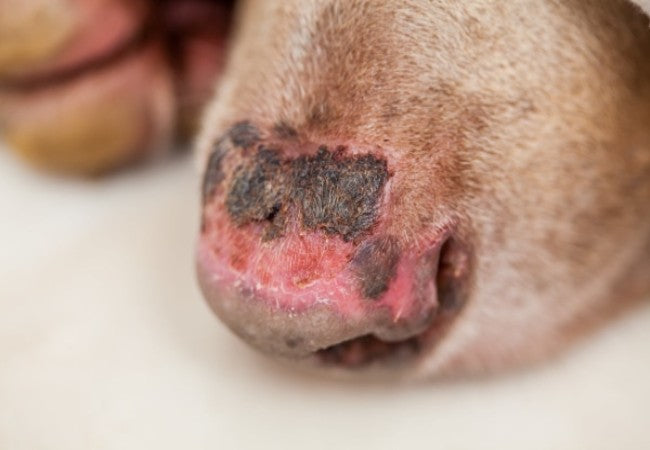Non‑Ulcerative Squamous Cell Carcinoma of the Nasal Planum in Dogs – Vet Guide 2025 🐶👃🩺

In this article
Non‑Ulcerative Squamous Cell Carcinoma of the Nasal Planum in Dogs – Vet Guide 2025 🐶👃🩺
By Dr. Duncan Houston BVSc
Hello! I'm Dr Duncan Houston, BVSc, founder of Ask A Vet. Squamous cell carcinoma (SCC) of the nasal planum— the hairless tip of your dog's nose—presents as ulcerated, bleeding lesions that worsen without treatment. Though rarely metastatic at diagnosis, it's locally invasive, causing discomfort and nasal obstruction. In this full-length 2025 guide, you'll learn how to recognize signs early, navigate diagnosis, choose between surgery and radiation, and manage supportive home care to maintain comfort and quality of life. Let’s uncover how you can support your dog's nose health. 💙
📚 What Is Nasal Planum SCC?
This malignant tumor originates from squamous epithelial cells on the nasal planum. In dogs, SCC is the most common tumor type at this site. Though it invades locally, it metastasizes in fewer than 15% of cases at diagnosis.
🧬 Risk Factors & Predisposition
- Mostly middle-aged to older dogs (mean ~10 years).
- Seen in light or non-pigmented nasal skin—often in labs, retrievers, Bassets, Collies, Schnauzers.
- UV exposure is a key risk; sun-loving pets are more vulnerable.
- No clear sex bias, though males may appear slightly overrepresented.
🚨 Clinical Signs & Presentation
- Ulcerated sores, bleeding, crusting on the nose.
- Sneezing, nasal discharge, and snout irritation.
- Facial swelling or deformity in advanced cases.
- Possible bleeding episodes (epistaxis) due to lesion friability.
- Rarely, metastasis detected in local lymph nodes (~12%).
🔍 Diagnostic Approach
- Physical Exam & History: evaluate ulcer size, duration, pigmentation loss, and collect staging info.
- CT Scan: gold standard for assessing lesion depth and bone invasion.
- Biopsy or fine-needle aspirate: confirms SCC diagnosis and grade the lesion.
- Staging: thoracic imaging and lymph node cytology—metastasis uncommon.
- Baseline labs: evaluate systemic health before surgery or radiation.
💉 Treatment Options
🔪 Surgery (Nasal Planectomy)
- Most effective—complete excision with clear margins yields the best long-term control.
- In a study of 17 dogs: 4/6 surgically treated dogs were cured; incomplete excision led to recurrence.
- Cosmetic reconstruction is possible using skin flaps—ask your surgeon for details.
- Stitch-line bleeding and sneezing common but manageable post-op.
🎯 Radiation Therapy
- Used if surgery is not feasible or for deeper lesions.
- In the 89-dog cohort, median survival was 452 days; surgery cases saw better outcomes.
- Brazilian study: radiation gave 95–417 days survival, with some achieving remission.
- Side effects: skin redness, hair loss, nasal mucosa inflammation—usually mild.
📦 Combined Therapy?
Surgery plus radiation had disappointing outcomes: all dogs recurred within 12 weeks in small retrospective study. Protocol sequencing is under study—consult your oncologist.
💊 Chemotherapy & Cryotherapy
- Cryosurgery may help treat superficial lesions when caught early—common in cat SCC protocols.
- Chemo alone is not indicated; considered only for advanced or metastatic cases.
📅 Prognosis & Survival
- No treatment: progression over months, often euthanasia needed within 2–4 months.
- Surgery alone: 4/6 cured in small study; effective, especially when done early.
- Local therapy (surgery or radiation): median survival ~452 days; disease progression shortened survival.
- Radiation alone: average 95–417 days; some achieve remission.
- Factors affecting outcome: early intervention and complete excision are key; metastasis remains rare.
🏡 Home & Palliative Care
- Humidifiers ease nasal discomfort, especially after surgery or radiation.
- Gentle cleaning of crusted areas with warm saline helps healing.
- Pain relief—NSAIDs like carprofen if indicated by your vet.
- Soft food and hydration ensure comfort during recovery.
- Avoid sun on exposed nose—use shade or pet-safe sunscreen.
- Monitor incision or lesion site for redness, discharge, or sneezing.
- Frequent vet check-ups—every 3–4 months to detect recurrence early.
✨ Key Takeaways
- SCC on the nasal planum appears as ulcerated, painless lesions that bleed and crust.
- Diagnosis confirmed via biopsy and staging through CT and lymph node assessment.
- Surgery with clear margins is the most reliable treatment; radiation is an option when surgery isn't feasible.
- Survival ranges from months (untreated) to over a year or more with treatment.
- Supportive home care and sun protection aid healing and comfort.
- Prompt diagnosis and treatment significantly improve chances—chat with your vet or Ask A Vet. 🩺
🐾 Ask A Vet
- Connect with a specialist via Ask A Vet for personalized advice on surgical planning or radiation schedules.
If your dog shows crusting, bleeding, or ulceration of the nose—especially if it persists—please seek veterinary attention immediately. Early, aggressive treatment offers the best chance to maintain quality of life. 🩺






